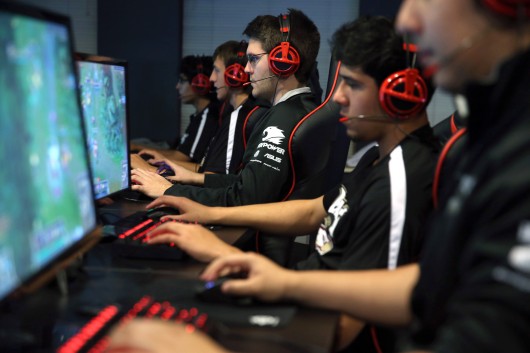
Austin Stadler, center, of Robert Morris University’s varsity video gaming team, practices in Chicago on Oct. 13 in advance of the team’s first competition.
Credit: Courtesy of TNS
We are conditioned to live in fear of those who play violent video games, and new studies keep coming from Ohio State’s Brad Bushman, a professor of communication and psychology, which agitate moral panic.
Bushman’s newest study suggests playing a violent game in 3-D makes a player exhibit more aggressive behavior after playing than when they play the same game in standard 2-D.
In this study, participants played a little bit of a violent game or a non-violent game and then went through a process to determine how aggressive they felt afterward.
This might make sense with games like “Super Mario Bros.,” which can be understood in bite-size chunks, but “Grand Theft Auto IV” was the particular violent game used in the study. “Grand Theft Auto IV” was designed as a dismal satire, a story of an immigrant to America who sought to escape the violence of his home country and is now resorting to violence again. It’s a glimpse into the soul of a murderer that can teach us about the nature of violence.
However, this study treated the game like a murder simulator by instructing participants to kill as many people as possible in 15 minutes. That’s not a mission in the game, and it’s not how the game is meant to be experienced. It’s certainly something the game equips you to do, but if you’re actually playing the game, you know that the game’s protagonist does it because he’s broken inside. That’s a powerful message the participants in the study are missing.
You wouldn’t skip through an action movie and only watch the parts where somebody is getting shot. You would watch the drama, too, and find out why the characters do what they do. By not giving participants context in the game, it ignores how the game is actually played.
The irony is that there are violent games which can convey a meaningful message with violence, and they can be played in 15 minutes. Something like “JFK: Reloaded”, which simulates the JFK assassination, or “The Slaying of Sandy Hook Elementary”, which puts you in the shoes of the Sandy Hook shooter, would both be perfect. Why not use these in a study? They could produce very different results.
Moreover, “Grand Theft Auto IV” doesn’t even come with a 3-D mode. This study must have been conducted with a modified version of the game. This is OK for the sake of the study, but it isn’t fair for anyone to say that “Grand Theft Auto IV,” as it was released in stores, engendered this 3-D amplification in player aggression.
That said, the “games as art” debate is over. Games won centuries ago when the Chinese used the board game Go as a means of philosophical self-expression.
Video games are more powerful than other media because they let a player take control. They don’t deserve to be placed in a cultural ghetto when the study of their meaning and craft is just as worthy as any other media. But, these studies perpetuate stereotypes of video games.
They also point out that games, because they are interactive, can make us more aggressive than other media can. I’m not ignoring this. It’s the reason games have ratings on their packaging. It’s the reason an upcoming game, “Hatred,” got a lot of flack after making it clear that is was going for shock value rather than a meaningful discussion of violence.
But we can’t single out games when every medium has two sides of the coin. OSU football looks wholesome, but a particularly awful celebratory riot after OSU beat Michigan at home in 2002 led to a mountain of drama and a task force to prevent such riots, as well as a conference at OSU. Despite its populist appeal and the virtues of the sport, it still shares the same problems. It just has a lot more advocates.
So, should we think more about football? Obviously! Should we think more about violence in games? Absolutely! But until games have advocates for their virtues, and until studies can study the average experience a player has with a video game instead of a 15-minute chunk, the conversation is going to engender moral panic that could keep games in that cultural ghetto for a long time, maybe forever.


